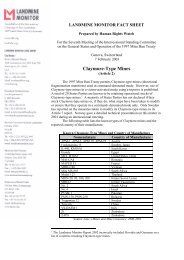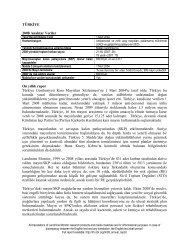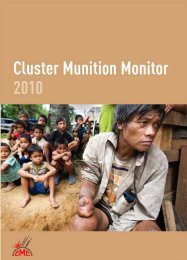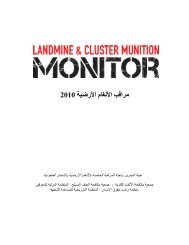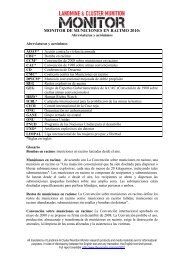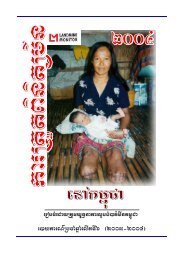Download PDF - Landmine and Cluster Munition Monitor
Download PDF - Landmine and Cluster Munition Monitor
Download PDF - Landmine and Cluster Munition Monitor
Create successful ePaper yourself
Turn your PDF publications into a flip-book with our unique Google optimized e-Paper software.
Casualties <strong>and</strong> Victim Assistance<br />
Evidence, as yet unconfirmed, of cluster munition use in Sudan <strong>and</strong> Syria emerged in the first half of 2012, but no<br />
casualties from recent use had been verified in either state as of 31 July 2012. 14 Both Sudan <strong>and</strong> Syria had cluster munition<br />
casualties from past use.<br />
Victim Assistance<br />
The Convention on <strong>Cluster</strong> <strong>Munition</strong>s requires that States Parties with cluster munition victims implement the following<br />
victim assistance activities:<br />
• Collect relevant data <strong>and</strong> assess the needs of cluster munition victims;<br />
• Coordinate victim assistance programs, including by designating a government focal point;<br />
• Develop a national plan, budget, <strong>and</strong> time frames for implementation;<br />
• Report <strong>and</strong> monitor obligations regarding implementation;<br />
• Consult with <strong>and</strong> actively involve cluster munition victims;<br />
• Provide adequate assistance, including medical care, rehabilitation, psychological support, <strong>and</strong> social <strong>and</strong><br />
economic inclusion for victims;<br />
• Implement national legislation according to the principles of international law; <strong>and</strong><br />
• Provide assistance that is gender- <strong>and</strong> age-sensitive as well as non-discriminatory.<br />
At meetings of the Convention on <strong>Cluster</strong> <strong>Munition</strong>s in 2011 <strong>and</strong> the first half of 2012, the co-coordinators on victim<br />
assistance, Austria <strong>and</strong> BiH, continued to focus attention on concrete steps necessary to implement the Vientiane<br />
Action Plan issued by the First Meeting of States Parties in November 2010. The Vientiane Action Plan provides a<br />
guide for prioritizing implementation of victim assistance in all its key aspects. 15 The co-coordinators explored synergies<br />
between the Convention on <strong>Cluster</strong> <strong>Munition</strong>s <strong>and</strong> other relevant international treaties, as well as cooperation between<br />
governments <strong>and</strong> NGOs. 16 There was also discussion on the question of how to identify <strong>and</strong> respond to the needs of<br />
families <strong>and</strong> communities affected by cluster munitions.<br />
The Beirut Progress Report adopted by the Second Meeting of States Parties in September 2011 reports on progress<br />
made in implementation of the Vientiane Action Plan. 17 According to the report, the majority of States Parties <strong>and</strong><br />
signatories with victim assistance obligations had implemented “some or all” of the relevant Vientiane action points by<br />
August 2011. 18 <strong>Monitor</strong> reporting confirms that almost all States Parties <strong>and</strong> signatories with cluster munition victims<br />
have taken steps to implement at least some of the victim assistance action points contained in the Vientiane Action Plan,<br />
but none have implemented all their obligations, <strong>and</strong> implementation of some actions remains inadequate. 19 States Parties<br />
are doing more than ever before to improve the lives of cluster munition victims, but far greater effort is needed by all.<br />
Assessing needs<br />
States Parties must make “every effort to collect reliable relevant data” <strong>and</strong> assess the needs of cluster munition<br />
victims. According to the Vientiane Action Plan, within one year of the convention’s entry into force for each State Party,<br />
all necessary data should have been collected <strong>and</strong> disaggregated by sex <strong>and</strong> age, <strong>and</strong> the needs <strong>and</strong> priorities of cluster<br />
munition victims should have been assessed. 20<br />
In 2011 <strong>and</strong> the first half of 2012, efforts to assess <strong>and</strong> address the needs of victims remained focused on survivors,<br />
with some inclusion of the family members of survivors <strong>and</strong> those people who were killed. Little attention was given to<br />
surveying the needs of cluster munition-contaminated communities <strong>and</strong>/or to determining the appropriate way to address<br />
their needs through data collection.<br />
14<br />
HRW press release, “Sudan: <strong>Cluster</strong> Bomb Found in Conflict Zone,” 25 May 2012. http://bit.ly/LtKyBr; <strong>and</strong> Aris Roussinos, “In a Sudanese<br />
field, cluster bomb evidence proves just how deadly this war has become,” The Independent, 24 May 2012. http://ind.pn/MJnSmm; HRW,<br />
“Syria: Evidence of <strong>Cluster</strong> <strong>Munition</strong>s Use by Syrian Forces,” 12 July 2012. http://bit.ly/NnjQP2.<br />
15<br />
The Vientiane Action Plan includes ten detailed <strong>and</strong> time-bound victim assistance actions specific to countries with cluster munition victims<br />
<strong>and</strong> three other actions relating to victim assistance in States Parties. The actions are related to medical care, rehabilitation <strong>and</strong> psychological<br />
support, social <strong>and</strong> economic inclusion, <strong>and</strong> other relevant services.<br />
16<br />
In the States Parties <strong>and</strong> signatories with the most cluster munition victims (Afghanistan, Iraq, Lao PDR <strong>and</strong> Lebanon), victim assistance<br />
services or supplies continued to be provided primarily by NGOs <strong>and</strong> international organizations while government authorities undertook<br />
coordination <strong>and</strong> some limited implementation.<br />
17<br />
“Draft Beirut Progress Report,” CCM/MSP/2011/WP.5, 25 August 2011. http://www.clusterconvention.org/files/2011/05/Beirut-Progress-<br />
Report-ODS-upload4.pdf.<br />
18<br />
Draft Beirut Progress Report,” CCM/MSP/2011/WP.5, 25 August 2011, p. 2. http://www.clusterconvention.org/files/2011/05/Beirut-<br />
Progress-Report-ODS-upload4.pdf.<br />
19<br />
For example, with respect to improving the availability of services in remote <strong>and</strong> rural areas (immediately), designating a focal point for<br />
victim assistance coordination (within six months), collecting all necessary data to assess needs, using existing coordination mechanisms for<br />
victim assistance or developing new ones, <strong>and</strong> reviewing national laws <strong>and</strong> policies (within one year).<br />
20<br />
Such data should be made available to all relevant stakeholders <strong>and</strong> contribute to national injury surveillance <strong>and</strong> other relevant data collection<br />
systems for use in program planning.<br />
55



